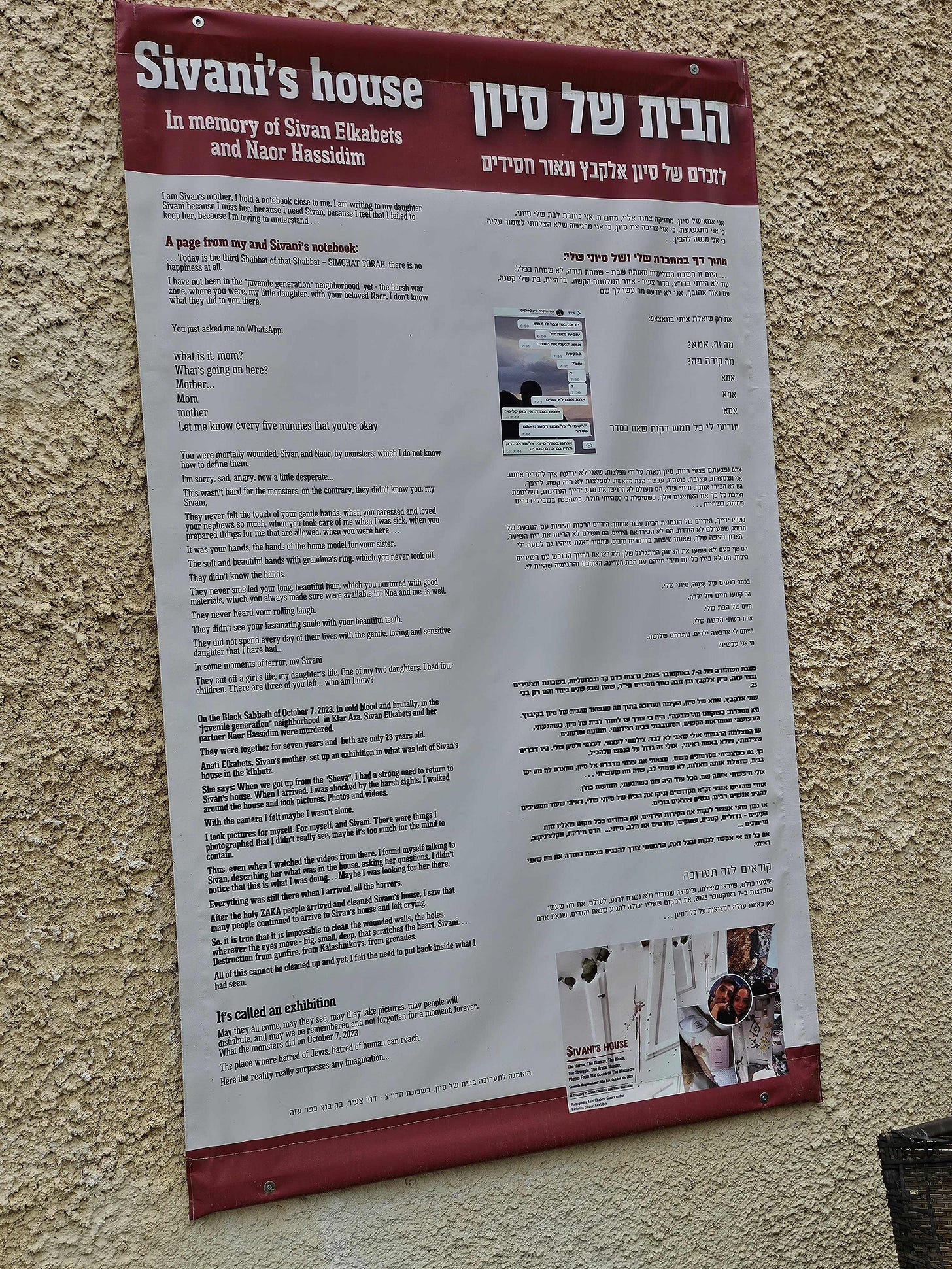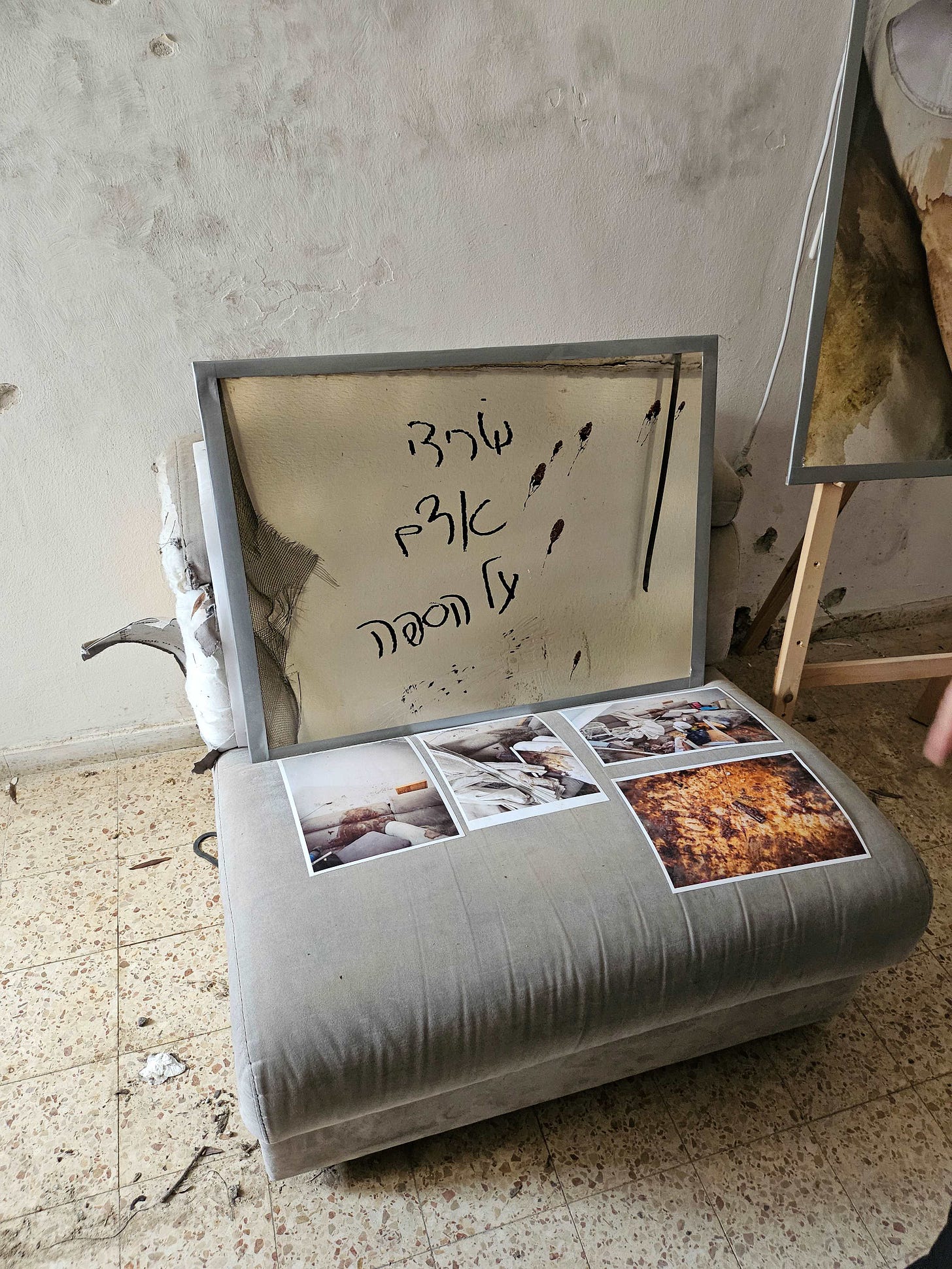Last week, I finally made the trip down south. I had been avoiding it for many reasons, but an opportunity presented itself when we were able to join an organized tour with people we know.
We met the group at Kfar Aza, one of the kibbutzim that was devastated on October 7th . Of the over 800 people who lived there, 64 were killed, and 19 were kidnapped.
We were met by a former resident (they are all former residents because, as of now, no one lives there) who was fortunate not to be there on October 7th. She told us how her former husband, the father of her children, was brutally murdered. Her 84-year-old mother was on the kibbutz during the attack. She survived because a rocket made a direct hit on her house, and it was assumed no one could have survived.
Young adults on the kibbutz usually move to their own small neighborhoods, where they are given a small private room. This way, they can do what young people do without disturbing the “grown-ups.”
There were about two dozen rooms along two pathways (over 40 rooms). One group was not attacked, while the other was decimated. More than 20 young people were brutally murdered. One was decapitated.
Most of the families have requested that people don’t enter the small rooms. One insists that you do. The photograph says everything
.
Walking through the rooms, you cannot get over the utter destruction. You feel the venom as you see over 100 bullet holes in a small space. I kept thinking, how many bullets does someone need? Why shoot everything?
The room is set up, as the parents wanted, as an exhibition. In the photo, there is a chair with a sign that translates to “Human remains found here.
”
The kibbutz is so close to Gaza. The entire time we were there, we heard the nonstop hum of our drones and the ongoing bombardment. Pillars of black smoke loomed in the background. The people of Kfar Aza felt that the Gazans were their neighbors and that one day there would be peace between them.
Our guide was one of those people. Her father was one of the founders of the kibbutz, and she was born there. She lived her entire life there until October 7th. Now, she is not sure she will return.
Who can blame her?
Now, she realizes that they do not want to live with us but instead want to live without us.
The last story she told was at the border fence of the kibbutz. You know that it is close to Gaza, but seeing how close is still shocking. She told one final story:
On October 7th, one of the young adults returned very late and drunk. He went to sleep in his safe room but kept the window open to get fresh air. He woke up around 8:30 a.m. to find that his home was being attacked. He was spared because the terrorists assumed no one would be in a safe room with the window open. He stayed very still and quiet but took the chance to look out. Once, he saw a group of terrorists with two young children, no more than 10 years old. They had book bags, as though they were in school, but instead, they were carrying ammunition. The terrorists figured that no Israeli soldier would shoot a child.
We then traveled to what is called the “car cemetery.” As people were fleeing the Nova festival when the attack started, many ran toward their cars. Hamas had set up ambushes for them, and Highway 232 has been dubbed the “Highway of Death.” When the rescue teams finally arrived, there were over 100 cars that had been shot and burned, most with people still in them.
They were all brought to one place, which has been set up as a memorial. One vehicle was an ambulance transporting the wounded. All the passengers were killed.
One car had so many bullet holes in it that all I could think about was the end of the movie Bonnie and Clyde. When Bonnie and Clyde are caught in an ambush, the deputies shoot so many bullets that the bodies keep moving as though they are still alive
.
Most people would question what amount of hate would cause someone to do this. How much anger? How depraved does someone need to be?
I didn’t ask any of those. The answers are clear to me.





Heartbreaking. I’m speechless
Peggy